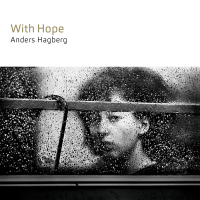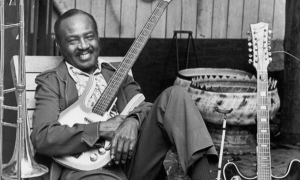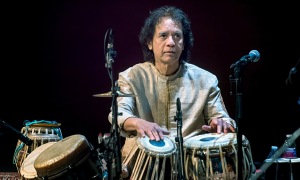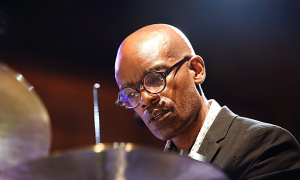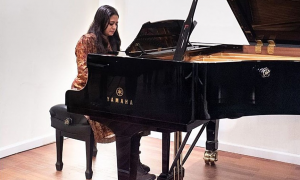Home » Jazz Articles » Under the Radar » The Word from Johannesburg, Part I: Nduduzo Makhathini
The Word from Johannesburg, Part I: Nduduzo Makhathini

Courtesy Universal Records
I am hugely influenced by the movements of the '60s in South Africa and in the US.
—Nduduzo Makhathini
"Jazz came to America three hundred years ago in chains. The psalm-singing Dutch traders, sailing in a man-of-war across the ocean in 1619, described their cargo as 'fourteen black African slaves for sale in his Majesty's colonies.' But priceless freight destined three centuries later to set a whole nation dancing went unnoted and unbilled..."
From West African tradition, basic elements, traditional rhythms, call and response (DuduMduri and Katse), improvisation and syncopation were pervasive in creating jazz but it wasn't until the genre had weaved its way through the world, that it came back to much of Africa as an entity. Sometimes, the music returned as it had left—in slavery. African music, traditional or popular, is immense and varied in scope but modern genres build on cross-fertilization with western popular music. Blues, jazz, and rumba originated in gradations of ethnic music and those of enslaved Africans. The musical traditions and practices of colonized West African countries blended, post-colonization and these practices can be seen today in the music of The Gambia, Senegal, Mali, and Nigeria.
South Africa
South Africa has had the most robust jazz scene on the continent, dating to the 1930s. The late South African singer, Miriam Makeba was a pioneer in bringing African jazz and Afropop to a Western audience. A Civil Rights activist and United Nations goodwill ambassador, she moved to New York City, where she began her recording career in 1960. After popularizing songs critical of apartheid, she was banned from returning to South Africa. In 1968 she married Stokely Carmichael, a leader of the Black Panther Party and the pair moved to Guinea on the Atlantic coast of West Africa. Makeba continued to tour in Africa and primarily performed Mbube, a blend of indigenous styles, ragtime, jazz, and sacred music. Mbube was later popularized by the South African group Ladysmith Black Mambazo. Makeba, Hugh Masakela, Abdullah Ibrahim, bassist Johnny Dyani, and saxophonist Dudu Pukwana are typically the South African artists U.S. jazz fans are familiar with.Nduduzo Makhathini
In September 2020 I interviewed pianist Nduduzo Makhathini, a native uMgungundlovu, a district within the KwaZulu-Natal municipality in South Africa. He was raised in a strict Christian environment, the son of a pianist and a guitarist, both singers. As a youth, he participated in church choirs and traditional isicathamiya groups, also propagated by Ladysmith Black Mambazo. Makhathini draws on a personal link between music, spirituality, and jazz improvisation in composing and performing. He incorporates elements of Western and South African jazz in his original works. That formula has paid off for Makhathini who signed with Blue Note Records releasing Modes of Communication: Letters from the Underworlds in Spring 2020.All About Jazz: Signing with Blue Note Records is a significant career benchmark. How does it impact your career?
Nduduzo Makhathini: It's truly an honor to be with Blue Note Records for many reasons. Firstly, I have always followed their catalogue and I relate so much to the artists they've been associated with over the years. Secondly, for my career, this was an important connection and I also feel my presence at Blue Note Records stands for some of the 'not so popular' contributions made by South African artists towards this art form at least since the 1930s.
AAJ: Like many jazz musicians in the United States, you grew up influenced by a musical family and spiritual music. In your case, spiritualism also meant receiving the gift of ubungoma—divination, and healing. How and when did you know that you had this ability and how do you incorporate it into your music?
NM: I recently spoke to my mother about when exactly I started showing signs of ubungoma, she tells me that it was at least around the age of 10. Due to my upbringing under Christianity, I only accepted the gift around 2012. Since then I have been significantly deliberate about the intersections between improvisation and African spirituality. One example that I have been exploring throughout my work is the idea of improvisation as a mode of divination. That is to say, improvisation aims at revealing the unknown as a kind of 'throwing of the bones.' In this sense, I enter improvisation as a ritual of connecting to 'elsewhere' where my ancestors reside. Hence Modes of Communication: Letters from the Underworlds I imagine a piece of improvisation as a text cited from another spiritual plane.
AAJ: You have toured extensively and had the opportunity to absorb the jazz scenes of different regions of Africa. What do you find are the primary differences between jazz in South Africa compared to countries such as The Gambia, Senegal, Mali, or any other part of West Africa?
NM: South Africa's jazz histories developed almost parallel to those of the United States. This is perhaps due to the fact that by the 1920s, American jazz reached our shores through the ports in Durban and Cape Town among others. But I also feel that within various South African traditional musics such as amahubo, there is something that is already translatable to jazz. I guess this is the case in West Africa too, but the jazz sensibility as part of a cultural sound has perhaps not developed in similar ways as it did down south.
AAJ: Your influences include Andrew Young, Randy Weston, Bheki Mseleku, and Zim Ngqawana. These artists encompass free jazz, avant-garde, mainstream jazz, and smooth jazz. It is a broad palette of interests but your music doesn't neatly fit into any one category. I wonder how (or if) these diverse influences play into your creative process?
NM: Yes, I am hugely influenced by the movements of the 60s in South Africa and in the US. That is to say, most of my music is founded within the realms of modal and free jazz. On the one hand, modal music was already engraved in our pre-colonial musics. While on the other hand, our traditional musics always relied on improvisation and elasticity. In this sense, the jazz sensibilities come natural to most South Africans.
There are many similarities in South African jazz and those of the US. It is also true that South African jazz stemmed out of deep listenings to American jazz. I guess what differs then is the unique cultural and linguistic richness that South Africa offers jazz musicians. Jazz in South Africa is defined by its traces and borrowings from its folk repertoires. It's worth mentioning that, even within our country there are various articulations of this music based on upbringing and interactions with our traditional ceremonial musics emerging from each tribe or ethnicities.
I think the evolution of jazz in South Africa is marked by its history. There is the apartheid period with all its restrictions which meant people looked towards jazz for their emancipation. Then within that, in the 80s jazz was introduced within curriculum, which meant a level of cultural discontinuities as the university ignored the developments that happened 'outside.' Then there is the post-apartheid period where jazz musicians are grappling with the notions of modernity while looking for these broken pasts. At a sonic level that has resulted in varieties of the art-form and a significantly rich songbook.
AAJ: Some U.S. jazz artists have used their music to express political views. This was especially true in the Civil Rights movement where Charles Mingus, Max Roach, and Nina Simone used their popularity to call attention to racial injustice. Have there been significant changes in South African music that reflect feelings about the eras of colonialism, apartheid, and post-apartheid?
NM: Yes, in South Africa Jazz has always reflected the sociopolitical contexts. Similarly, to the US, during the civil rights movements—in South Africa the jazz of the 60s was marked by the 'Sharpville Massacre' during a march against apartheid... those that were in exile such as Abdullah Ibrahim, Hugh Masekela, and Miriam Makeba among others, collectively represented what was happening in South Africa. So, there are many connections, and some resulted in many collaborations between South African jazz musicians and the US in the diaspora. Ibrahim and Sathima Benjamin worked with Duke Ellington, while Johnny Dyani worked with Mal Waldron, Mseleku with Don Cherry, there are several other examples.
AAJ: Jazz listeners in the U.S. have had limited exposure to South African jazz. Typically, they hear the music of Abdullah Ibrahim, Hugh Masekela, Miriam Makeba, and Ladysmith Black Mambazo. Who are artists we should be looking for?
NM: Yes, it is sad that the world doesn't know much about South Africa's contributions to the art-form. I think from the earlier generation it is important to know about The Soul Jazzmen and The Blue Notes. Then Spirits Rejoice with Bheki Mseleku and Malombo with Philip Tabane. Then Voice, Feya Faku, and Busi Mhlongo. Of the recent generation, of course, Omagugu, Ayanda Sikade, Linda Sikhakhane, Sakhile Simani, Thandi Ntuli, Mbuso Khoza, and Afrika Mkhize. There are so many musicians.
AAJ: Do you see your music taking a new direction in the future and what projects are you thinking about?
NM: During this lockdown, I have been writing music, I have presented some of it online. I definitely think I have a 'new sound' since the world that we once thought we knew has now shown us how fragile we are. So, I have been thinking of sound in four movements; preparation, invocation, healing, and rebirth. I strongly feel that there is a shift in consciousness, we have been projecting from a space of stillness and gentleness, while paired with all the social inequalities that have been particularly exposed in South Africa but also in the US. The current sounds emerge out of these layers of what it means to be in the world in this moment and beyond.
Thanks to Cem Kurosman, Sr. Director of Publicity and Digital Marketing at Blue Note Records/Capitol Music Group Universal Records, for facilitating the Nduduzo Makhathini interview.
In The Word from Johannesburg, Part II we will consider jazz in South Africa from the broad perspective of Brenda Sisane, the host of the Johannesburg KAYA-FM radio program The Art of Sunday where she plays and promotes jazz, interviewing an eclectic mix of jazz artists. Ms. Sisane's program reaches much of the African continent and streams globally.
Selected Discology
Nduduzo Makhathini: Modes of Communication: Letters from the Underworlds (Blue Note Records) The Blue Note label debut of Nduduzo Makhathini's Modes of Communication: Letters from the Underworlds marks the first time the eighty-one-year-old label has recorded a leader from South Africa.
The Blue Note label debut of Nduduzo Makhathini's Modes of Communication: Letters from the Underworlds marks the first time the eighty-one-year-old label has recorded a leader from South Africa. The eleven tracks are Makhathini originals and they pay tribute to ancestral voices and American influences such as John Coltrane. Each composition is named for one of the eleven dominant languages of South Africa. Makhathini blurs the line between the significant Cape Town jazz bands and Western influences, particularly the jazz music of the Civil Rights era. The composer is influenced by having lived under apartheid and post-apartheid regimes. The music is commanding and compelling, delivered by top South African musicians except for American alto saxophonist Logan Richardson.
Tracks: Yehlisan'uMoya; Saziwa Nguwe; Beneath The Earth; Unyazi; Isithunywa; Umlotha; Shine; On The Other Side; Umyalez'oPhuthumayo; Indawu; Emaphusheni.
Personnel: Nduduzo Makhathini: piano, voice (3,4); Linda Sikhakhane: tenor sax; Ayanda Sikade: drums; Zwelakhe-Duma Bell La Pere: bass; Logan Richardson: alto sax; Ndabo Zulu: trumpet; Gontse Makhene: percussion, voice (4); Omagugu Makhathini: voice; Nailah Makhathini: voice (3,10), Asanda Msaki: voice (3); Thingo Makhathini: voice; (3); MXO: voice (11).
Tags
PREVIOUS / NEXT
Nduduzo Makhathini Concerts
Support All About Jazz
 All About Jazz has been a pillar of jazz since 1995, championing it as an art form and, more importantly, supporting the musicians who make it. Our enduring commitment has made "AAJ" one of the most culturally important websites of its kind, read by hundreds of thousands of fans, musicians and industry figures every month.
All About Jazz has been a pillar of jazz since 1995, championing it as an art form and, more importantly, supporting the musicians who make it. Our enduring commitment has made "AAJ" one of the most culturally important websites of its kind, read by hundreds of thousands of fans, musicians and industry figures every month.









